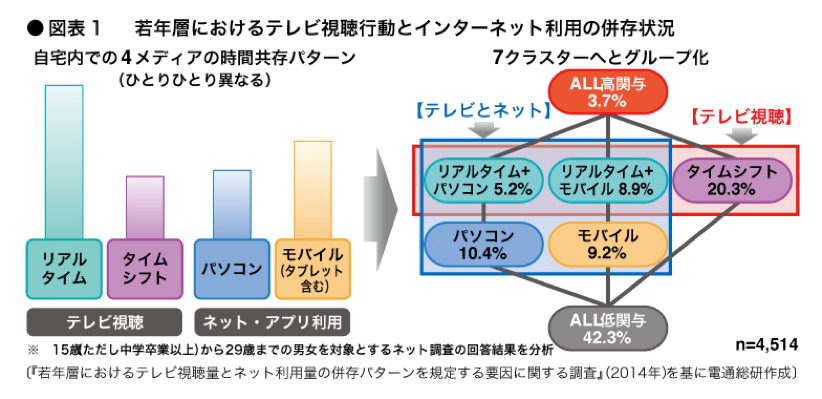Previously, we analyzed young people's video viewing habits based on results from a " Web Survey onVideoViewing " and a "Survey on Video Viewing During Commutes/Commutes to School." Overall, home viewing remains dominant, but we found potential for expanding viewing opportunities during commutes/commutes to school. This time, we delve deeper into the media viewing behavior of young people from a different angle: the coexistence of television viewing and internet use, while adding the elements of real-time TV viewing and time-shifted viewing.
◆ One in seven young viewers focuses on real-time viewing
First, we categorized young people's in-home media behaviors into "TV-centered patterns" and "Internet-centered patterns." These were further subdivided into "real-time viewing-centered patterns" and "time-shift viewing-centered patterns," as well as "PC-centered patterns" and "mobile-centered patterns." Based on these classifications, we analyzed the contact time for four in-home media types: "Real-time viewing," "Time-shifted viewing," "PC," and "Mobile." The results revealed seven distinct clusters, as shown in Figure 1.

The left side of Figure 1 represents mind share based on contact time with these four media, while the right side shows the volume of each media coexistence pattern.
High involvement users (those highly engaged with all media—TV, recorders, PCs, and mobile—and utilizing them extensively) constitute a minority at 3.7%. Among the remaining segments, 33.7% fall into the blue box category [TV and Internet coexist or compete], while 34.4% belong to the red box category [broad segment watching TV across real-time to time-shifted viewing].
Breaking this down further, 20.3% are "timeshifters" (purple segment) who watch TV but primarily timeshift their viewing, while the combined total of "real-time + PC" and "real-time + mobile" (the two emerald green segments) who watch TV but primarily watch in real time is only 14.1%.
In short, this indicates that only one in seven young people watch television primarily in real time, suggesting that the perception of television as something to be watched in real time is becoming less established among young viewers. In the next section, we will analyze the factors that shape the patterns of time allocation among these four media and devices within the same young demographic.
◆ Disposable Time Significantly Influences Concurrent Media Usage
Figure 2 lists data for each cluster, including gender ratio, average age, marital status, occupation, and time of waking at home.

These data reveal the characteristics of each cluster.
① "Real-Time + PC" Cluster Profile (Composition: 5.2%)
Unmarried men in their 20s. The highest proportion are "unemployed," indicating long hours spent at home. Their real-time TV viewing time and PC usage time are exceptionally long, with PC usage exceeding TV by 43 minutes per day.
② "Live TV + Mobile" Cluster Profile (Composition Ratio: 8.9%)
Primarily unmarried and married women in their 20s. Among the notable clusters, this group has the longest real-time TV viewing time at 275 minutes.
③ "Timeshift" Cluster Image (Composition Ratio: 20.3%)
This cluster has the largest composition ratio among the five clusters. It also has the shortest time spent at home after waking up, with only 8.35 hours per day spent at home. Conversely, this group spends a long time away from home. Due to the short time spent at home, it appears they are forced to reduce live viewing and instead watch time-shifted content.
④ "PC" Cluster Profile (Composition Ratio: 10.4%)
This group consists mostly of unmarried men in their 20s who are unemployed. Similar to Cluster ①, they spend a significant amount of time using computers. Comparing Clusters ① and ④ shows that unemployed consumers tend to utilize computers more heavily.
⑤ "Mobile" Cluster Image (Composition Ratio: 9.2%)
Unmarried women in their 20s and high school girls. They boast overwhelming mobile contact time. With shorter time spent at home after waking up, activities like real-time viewing, time-shifted viewing, and PC use within the home generally show shorter contact times compared to mobile.
◆ Impact of Social Change on Media
Finally, we introduce one aspect of how the "Women's Social Advancement" initiative from the Second Abe Cabinet's New Growth Strategy impacts media. Daily TV viewing time tends to be shorter among unmarried individuals compared to married individuals, among full-time workers compared to part-time workers, and among those with higher education levels compared to those with lower education levels (Figure 3).

When societal changes occur that promote women's participation in the workforce, it is inevitable that this will affect not only television but the entire media environment. Depending on the government's future social policies, it is certain that television viewing environments and attitudes will be impacted in some way. Media and content players will be required to adapt their content provision methods to respond to such societal changes.
[Survey Summary: Factors Determining Coexisting Patterns of Television Viewing and Internet Usage Among Young People]
・Survey Method: Internet survey
・Survey Area: Tokyo and three prefectures (Kanagawa, Chiba, Saitama)
・Survey Participants: 4,514 males and females aged 15-29 (excluding junior high school students)
・Survey Period: August 13–17, 2014
・Research Company: Video Research Ltd.





